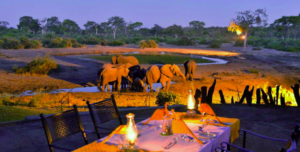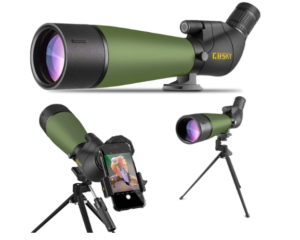
Hunting in Canada Full Guide.
Immerse yourself in the wild and exciting world of hunting as we travel throughout Canada’s various regions. Canada is a sanctuary for outdoor enthusiasts and hunters alike, with its enormous woods, broad plains, beautiful mountains, and pure rivers. From pursuing spectacular large game to perfecting your upland bird hunting abilities, Canada provides a variety of activities that link you with both nature and tradition.
We go deep into the art and science of hunting in Canada in this guide, revealing its rich history, ethical practises, legal rules, and the profound connection it generates between hunters and the great Canadian wilderness.
How to Hunt in Canada
Hunting in Canada is a pleasant and unique experience, but it takes careful planning, attention to rules, and consideration for wildlife and the environment. Here’s a detailed guide about hunting in Canada to help you get started:
Step 1: Conducting Research and Planning:
Choose a Province or Territory: Select a province or territory based on the species you want to hunt and the sort of hunting experience you want.
Examine restrictions: Learn about the hunting restrictions and seasons in your selected place. Regulations differ depending on area and species.
Determine the game species you intend to pursue and acquire the necessary hunting gear, clothes, rifles, ammo, and accessories.
Step 2: Permits and Licencing:
Obtain a Hunting Licence: Contact the applicable provincial or territorial wildlife agency to apply for a hunting licence. Non-residents may face additional obligations.
Application for a Tag or Permit: Some species require specific tags or permits. Apply for these tags while keeping application deadlines and processes in mind.
Step 3: Education and Safety:
Depending on your degree of experience, consider attending a hunter education course to learn about weapon safety, ethics, and conservation practises.
Firearm Safety: If you use firearms, be sure you understand firearm safety guidelines, as well as correct handling, storage, and transportation.
Step 4: Preparing for the Hunt:
Scouting Locations: Familiarise oneself with potential hunting regions by using maps, internet tools, and, if feasible, scouting visits.
Pack essentials such as proper clothes, camping gear (if necessary), food, water, navigation equipment, a first-aid kit, and any licences and permissions required.
Step 5: During the Hunt:
Hunt Ethically: Adhere to ethical hunting practises such as fair pursuit ethics, compassionate harvesting, and wildlife respect.
Respect the Law: Only hunt during approved seasons, adhere to bag restrictions, and utilise legal tactics and equipment.
Step 6: After the Hunt:
Field Dressing: Field dress and treat collected game properly to ensure optimum meat preservation and reduce waste.
Reporting: If necessary, report your catch to the relevant wildlife agency in accordance with their reporting protocols.
Step 7: Environmental Stewardship:
Leave No Trace: Reduce your environmental effect by following Leave No Trace practises such as appropriate garbage disposal and campground management.
Wildlife Conservation: Help conserve wildlife by taking part in wildlife management surveys and programmes.
Step 8: Continued Learning:
Reflect and Learn: Think about your hunting experience, what you learned from it, and how you might improve your abilities and knowledge.
Remain Informed: legislation and rules might change, so remain up to speed on any changes to hunting legislation and practises.
Remember that hunting restrictions and practises might vary greatly between provinces and territories, as well as between species. Before organising and performing a hunt, always check official sources, such as provincial or territorial wildlife organisations, for the most up-to-date and accurate information.
Hunting Seasons In Canada Explained

Hunting seasons in Canada differ by province and territory, as well as per species. Each region has its own set of legislation to guarantee animal population conservation and sustainable hunting practises. While I can’t get into specifics for each place, here’s a broad explanation of how hunting seasons work in Canada:
Duration and timing:
Hunting seasons are time periods when hunting for certain animals is authorised.
Seasons are set to coincide with wildlife’s natural life cycles, such as breeding, migration, and hibernation, in order to minimise disturbance and improve population health.
Different Species, Different Seasons:
Hunting seasons vary according to game species. Waterfowl hunting seasons, for example, may differ from large game hunting seasons such as deer or moose.
Some species may have distinct seasons for various hunting tactics (firearms, archery) or age groups (youth, adult).
Bag Restrictions:
Bag limitations describe the maximum number of animals that a hunter may take throughout the course of a hunting season.
Bag restrictions aid in the management of wildlife populations and the prevention of overharvesting.
Permits and Licencing:
Hunters must have a current hunting licence and, in some situations, permits or tags for specific species.
The rules and fees for licencing differ by province and territory.
Special Seasons:
Special hunting seasons may be established in some provinces and territories for specific objectives, such as managing overpopulated animals or addressing conservation problems.
Migratory Birds:
Waterfowl hunting is governed by federal authorities in Canada, notably Environment and Climate Change Canada.
Migratory bird hunting seasons are frequently established based on the migratory patterns of the species.
Non-Resident Regulations:
When opposed to citizens, non-resident hunters may have differing hunting seasons, bag restrictions, and criteria.
Non-resident hunters may have limited access to tags in several provinces.
Reporting Requirements:
Hunters may be forced to submit their catch to wildlife officials in specific situations. Data reporting aids in population health monitoring and informs future management decisions.
It’s crucial to remember that hunting restrictions and seasons might change each year and are subject to change. Consult the official website of the appropriate wildlife agency or department to guarantee you have correct and up-to-date information on hunting seasons in a certain province or region.
What the best hunting locations in Canada?

Canada has a wide variety of hunting destinations, each with its own distinct terrain and rich animals. The greatest hunting spots will differ based on the species you’re after and your particular preferences. Here are some of the best hunting spots in Canada:
Alberta:
Alberta, known for its immense wilderness and various game species, provides good prospects for big game hunting, including elk, moose, deer, and black bear. The Rocky Mountains and boreal woods provide as beautiful settings.
The province of British Columbia:
British Columbia’s coastal rainforests and steep topography make it attractive for hunting animals such as black bear, elk, deer, and mountain goat. The extensive wilderness regions of the province provide hard hunting opportunities.
Saskatchewan:
This prairie province is well-known for its waterfowl hunting, particularly in the Prairie Pothole region’s wetlands. White-tailed deer, mule deer, and upland birds can also be found in Saskatchewan.
Manitoba:
Manitoba has a wide range of hunting opportunities, including waterfowl hunting in its many lakes and rivers. White-tailed deer, black bear, and moose hunting are also popular in the province.
Ontario:
Ontario offers a wide range of hunting possibilities, from whitetail deer and black bear in its woods to waterfowl in its numerous lakes and marshes.
Quebec:
White-tailed deer, black bears, and moose live in Quebec’s immense wilderness. The province is also recognised for its strong hunting tradition and great waterfowl hunting.
Province of Newfoundland and Labrador:
This area is well-known for its moose and caribou hunting, as well as prospects for black bear and small game hunting. The harsh terrain offer a one-of-a-kind hunting experience.
Yukon:
For daring hunters, the Yukon provides distant and difficult hunts for moose, caribou, Dall sheep, and grizzly bear.
Northwest Territories:
This northern area is well-known for its arctic barren-ground caribou hunting, as well as muskox and other large game chances.
Nunavut:
Nunavut’s extensive Arctic tundra provides unique hunting opportunities for animals such as polar bear, muskox, and arctic hare.
Consider the species you want to hunt, the sort of terrain you prefer, and the region’s special hunting restrictions and seasons when picking a hunting area in Canada. Before you go hunting, make sure you have all of the necessary licences, permits, and understanding of local hunting rules.
What animals can be hunted in Canada.

In Canada, hunting options include a wide range of game animals, which are classified according to their traits and habitats. The following are the primary types of animals that can be hunted in Canada:
Big Game:
Big game refers to bigger animals and is frequently the target of hunting trips. Because of their size and behaviour, these creatures need specialised equipment and abilities. In Canada, common large game animals include:
White-tailed Deer: A popular and ubiquitous large game species, they may be found in a variety of environments across the country.
Mule deer are mostly found in western Canada and live in a variety of habitats.
Moose: These big creatures live in woods and marshes, and hunting them is an important cultural and recreational activity.
Elk: Elk are mostly found in western Canada, where they live in woods, meadows, and hilly areas.
Black Bear: These omnivorous creatures are found in several regions and provide a hard hunt.
Small Game:
Small game species are typically smaller and may include birds and animals. Small game hunting is typically accessible and may be a fantastic way to get started. Among the most common small game species are:
Ruffed Grouse: These woodland birds are famous among hunters.
Snowshoe Hare: A favourite of small game hunters, they live in northern locations.
Cottontail rabbits: are found in a variety of settings and give an easy hunting choice.
Red squirrels and ground squirrels are frequently hunted by hunters.
Upland Birds:
Upland birds live on meadows and open spaces. Walking and flushing birds from cover is a common method of hunting them. Among the most common upland bird species are:
- Ring-necked Pheasant: Introduced to several provinces, pheasants provide exciting hunting opportunities.
- Hungarian Partridge: These birds prefer wide spaces.
- Sharp-tailed Grouse: Because they live in grasslands, hunting them may be an exciting experience.
- Spruce Grouse: Found in coniferous woods, they provide a unique upland hunt.
Waterfowl:
Wetlands, marshes, and bodies of water are used for waterfowl hunting. Ducks and geese are examples of waterfowl, and hunting them necessitates the use of decoys, blinds, and specialised equipment. Among the most common waterfowl species are:
Mallard Duck:
One of the most common and well-known duck species.
Canada Goose: Found throughout Canada, they provide hard waterfowl hunting.
Teal, Pintail, and Wigeon: different duck species offer a variety of hunting chances.
Predators and Furbearers:
Predators and furbearing animals can be hunted for a variety of purposes, including population management and fur production. This category includes the following species:
Coyote: Pursued for population control and sport.
Red Fox: Red foxes live in a variety of environments and can be killed for fur for predator control.
Grey (Timber) Wolf: Hunting rules differ by location and are frequently geared towards population management.
Bobcat, Lynx, Fisher, Marten: These furbearers are sought after by trappers for their valuable pelts.
Keep in mind that hunting regulations, seasons, and bag limits can vary significantly by province and territory.
What animals are illegal to Hunt in Canada

There are strong rules in place in Canada to protect and conserve specific species. It is critical that hunters are aware of these rules and adhere to ethical and lawful hunting practises. While restrictions vary by province and territory, the following species are typically banned to hunt in Canada:
Endangered and Threatened Species:
It is strictly forbidden to hunt endangered or vulnerable animals. These species are protected by federal and provincial laws in order to avoid extinction and encourage recovery. Here are several examples:
Southern Mountain Caribou: Endangered due to population decline.
North Atlantic Right Whale: This marine creature is critically endangered.
Predatory Birds:
Hunting birds of prey such as eagles, hawks, and owls is typically prohibited due to their protected status as key ecosystem components.
Non-Game Species:
Certain animals that are not commonly hunted for fun, food, or fur may be protected as well. These species help to maintain ecosystem health and biodiversity. Here are several examples:
Bald Eagle: A protected species owing to its cultural and ecological importance.
The peregrine falcon is protected because of its endangered status and rehabilitation efforts.
Sea Mammals:
Seals, sea lions, and whales are frequently protected under the Marine Mammal Regulations to preserve their protection and well-being.
Species that are not native or are invasive:
Non-native and invasive species hunting may be controlled or forbidden in some locations to conserve native animals and prevent ecological impact.
Species of Game Outside of Designated Seasons:
It is prohibited to hunt some species outside of defined hunting seasons or without the necessary licences and permits. Poaching and hunting without a permit are both criminal offences.
It is critical to examine and comprehend the hunting restrictions in the province or territory where you intend to hunt.

FAQs about Hunting in Canada
Is Canada good for hunting?
Yes, because of its large and diverse landscapes, abundant animal populations, and well-managed hunting restrictions, Canada is recognised for providing outstanding hunting chances. The wilderness regions, woods, and national parks of Canada provide habitat for a variety of game animals, making it a popular hunting destination for both domestic and foreign hunters.
Some of the most popular game species for hunting in Canada include:
White-tailed deer
Mule deer
Elk
Moose
Black bear
Waterfowl (ducks, geese)
Upland game birds (grouse, pheasant)
Caribou
Bison
Predators like wolves and coyotes. Because each province and territory in Canada has its own hunting regulations and seasons, it’s essential to study and understand the exact rules and requirements for the region you want to hunt.
Can I hunt as a non-resident in Canada?
Non-residents can hunt in Canada, however there may be restrictions, licencing procedures, and costs. It is critical to discover and comprehend the hunting guidelines and procedures of the province or territory you want to visit.
Do I need any licences or permissions to hunt in Canada?
A valid hunting licence issued by the province or territory where you intend to hunt is usually required. Furthermore, certain species may need particular permissions or tags. The licencing regulations and costs vary by location.
When is the Canadian hunting season?
Hunting seasons differ depending on the species and locality. They are usually dictated by wildlife’s natural life cycles, such as breeding and migratory patterns. It’s critical to research the hunting seasons for the species you’re interested in as well as the province or territory you’ll be hunting in.
In Canada, what kinds of game may I hunt?
Big game (e.g., deer, moose, bear), small game (e.g., rabbits, squirrels), upland birds (e.g., grouse, pheasants), waterfowl (e.g., ducks, geese), and predators (e.g., coyotes) are all available for hunting in Canada. Regulations and availability differ according to location.
Are there any limits on hunting techniques in Canada?
Yes, hunting tactics and equipment are frequently regulated. These restrictions guarantee that hunting is done ethically and responsibly. Certain tactics, including as baiting, electronic calls, or spotlighting, may be prohibited in some provinces.
Can I bring hunting rifles into Canada?
Non-resident hunters are permitted to carry firearms into Canada for hunting purposes, but must follow certain processes and receive the necessary licences. It is critical to become acquainted with Canadian weapon importation restrictions and to declare your firearms at the border.
Is it necessary for me to attend a hunter education course in Canada?
Hunter education classes are highly recommended, especially for first-time hunters. They address topics such as weapon safety, hunting ethics, conservation ideals, and restrictions. Certain forms of hunting may necessitate hunter education certification in some provinces.
Can I hunt on Canadian public lands?
Yes, hunting on public lands is legal in Canada, but you must obey the restrictions unique to the region where you intend to hunt. Additional permits or access rights may be required in some areas.
What are bag limits in Canada and why do they matter?
The quantity of animals you can harvest during a hunting season is specified by bag restrictions. Bag restrictions aid in wildlife population management, avoid overharvesting, and promote sustainable hunting practises.
Is there an age limit for hunting in Canada?
Yes, there are age limits for hunting, which vary by province or area. Minimum age restrictions for acquiring a hunting licence or engaging in particular sorts of hunting may exist in some areas. For age-specific rules, contact the appropriate wildlife agency.
Can I use a crossbow to hunt in Canada?
Regulations for crossbow hunting differ by province and area. During defined hunting seasons, several localities allow crossbow hunting for specific species. It is critical to check crossbow hunting restrictions in the region where you intend to hunt.
Is hunting permitted in national parks or protected areas in Canada?
Hunting is typically illegal in Canada’s national parks and other protected areas. These are designated places for conservation and enjoyment. For detailed laws and regulations, always check with park officials.
Can I use electronic devices while hunting in Canada?
Electronic devices, like as electronic calls, may be prohibited in specific regions or species. Electronic device regulations vary by location, so it’s critical to examine the exact guidelines in the region where you want to hunt.
Related
Elk hunting Canada. How and Where can you Hunt elks in Canada.






